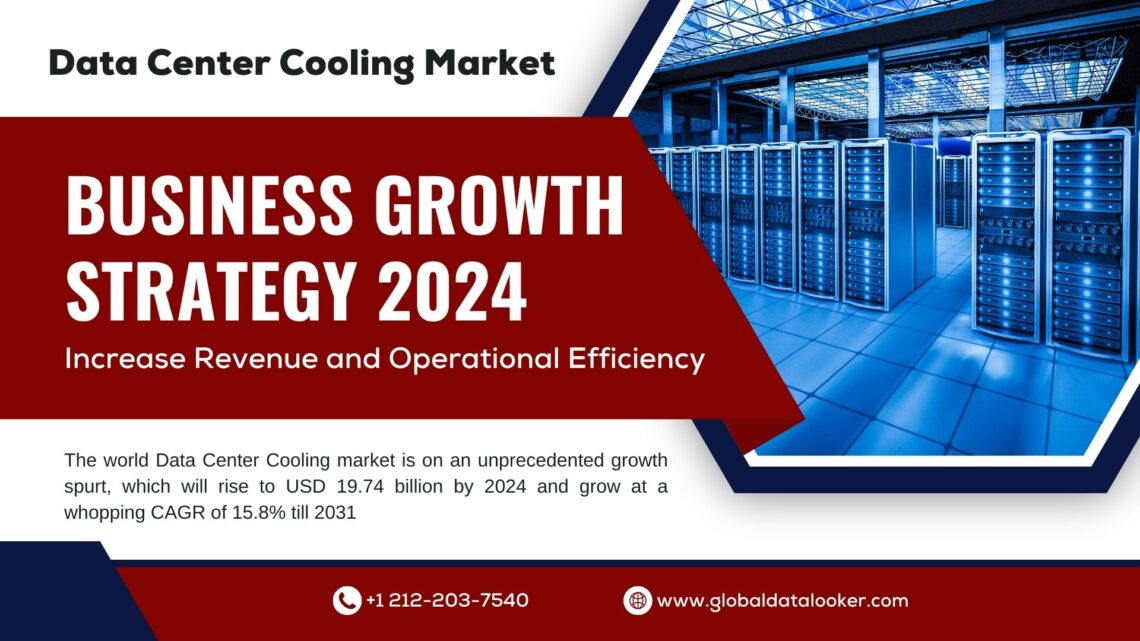Global Data Center Cooling Market to Reach USD 19.74 Billion in 2024, Projected to Grow at a 15.8% CAGR by 2031

Data centres are the network for everything we do online in the modern age. The bigger they get, the more demanding they will be on cooling systems. The world Data Center Cooling Market is on an unprecedented growth spurt, which will rise to USD 19.74 billion by 2024 and grow at a whopping CAGR of 15.8% till 2031. That growth is more than just numbers: it’s a testament to growing demand for stable infrastructure to secure our data and make it available.
With technology, so do the issues of keeping temperatures right in such large spaces. The best air conditioners or the latest containment systems: solutions are coming to give you the highest performance without compromising energy efficiency.
Data Center Cooling Market Size and Trends
This Data Center Cooling market is booming on the back of the surge of digital data. When companies have a lot of IT infrastructure, cooling is the key to keeping things working. The year 2020 was a market-revolutionary one as the COVID-19 pandemic led to an exponential growth in online activity and data creation. There is a trend in this industry to use green technologies. Energy-savings aren’t trendy, they’re a must as businesses look to save energy and resources.
And then there is also the growth of cloud computing and big data analytics which increases the need for strong cooling. Businesses want durable products that are able to absorb more heat without sacrificing performance or uptime. New markets are contributing to this growth too. Areas with rising tech based industries mean more spending on cutting edge cooling and local strategies. Stakeholders have to be nimble enough to adapt to changing industry demands and technologies as these dynamics unfold.
Global Data Center Cooling Market is a multidimensional one and the demands of data centers in the entire world. This division lets companies pinpoint which segments they can focus on and invest in. Major parts are component types, solutions, services, and applications. Every type gives us different perspective on the market and customers. Part descriptions are based on cooling like CRAC or liquid cooling. These parts are necessary for proper high-density heat. Solution discussions are about solutions like hot aisle/cold aisle containment. Such strategies result in the improvement of efficiency and decrease of operating expenses.
Services includes repair and services for long-term resale of air conditioners. Also, application insights cater to industry-based needs in industries from finance to healthcare. This complete segmentation in turn determines the future course of the Data Center Cooling Market by providing solutions to the different concerns of the stakeholders involved in the market.
Report Coverage & Deliverables
The report presents a detailed study of the global data center cooling market. It covers industry-defining metrics and the trends for its future. It comprises of the market size, previous and forecast revenue, CAGR, and market share. In-depth analysis of driving, hindering, prevailing, and opportunities in the industry can also be found in the report. Strict segmentation shows you components, solutions, services, and types. Every section is analysed thoroughly in order to identify gaps for stakeholders. The dynamics of markets are discussed as well to better comprehend what drives demand and supply. Big issues facing the industry are covered too.
Furthermore, regional segmentations illustrate data center cooling requirements by region. This data can be leveraged by companies to adjust their approach accordingly. It also contains company profiles of market leaders such as financials, product portfolio and initiatives. The report also contains a SWOT analysis of key competitors for better decision making. Finally, the report gives you projections of growth for the future and deliverables include useful intelligence to be used by decision makers. Data-based recommendations allow organizations to move with ease through this new world.
Component Insights
Data center cooling consists of all those things that keep you and your equipment temperature at the right level. These are air conditioners, chillers, cooling towers, and CRAC (Computer Room Air Conditioning). Coolers take out the heat that’s emitted by servers. They are built to provide cool air while controlling energy use effectively. It is cool by way of chillers. They deliver cooled liquid that circulates through the plant, picking up heat from hot rooms and circulating it back to the cooling. Cooling towers do even more of this by evaporating heat into the atmosphere. They’re efficient thermally and water-efficient – all of which is very important today in an eco-friendly world. Every element has to co-exist with others to produce a workable cooling architecture for a particular data center. This interconnectedness drives innovation as enterprises look for cost effective solutions to their problems.
Solution Insights
The solutions in the data center cooling industry are numerous and customized according to different requirements of the operation. And liquid cooling is one of the best in the business when it comes to high density servers. This system provides efficient heat extraction with low energy. And there are still systems in the air. They use the latest in airflow management to maintain the proper temperatures in the server racks. Novel approaches such as direct-to-chip cooling are on the rise, too. Such solutions provide targeted heat management at key areas for even higher performance. So has cloud integration – even in an old-school fashion. Hybrid systems that include multiple cooling technologies are flexible and scalable for new applications. In an age of companies that place a high value on the environment, sustainable alternatives are appearing rapidly. Recycling waste heat or the use of renewable materials are green solutions that cut your carbon footprint.
Services Insights
The services sector of the data center cooling market is key. It includes installation, servicing and consultation services for energy efficient cooling. Installation services makes sure everything is operational from the get-go. This minimises system sluggishness and increases life. Experienced technicians use best practices based on the facility needs. Maintenance is equally crucial. System checks keep systems up and running so that no one has to spend a fortune on downtime. Regular service can catch issues before they become bigger issues. Consulting services provide data about energy savings and systems optimization. : Experts evaluate existing designs and recommend upgrades or redesigns to optimise heat flow.
Data usage increases and these services become more critical to maintain plant optimum conditions and keep costs low. As the technology is changing, more innovations are happening in this space as well, which open up new possibilities for businesses that need to modernize their infrastructure.
Type Insights
The cooling system type used in data centres makes a big difference in both efficiency and performance. Different types fit different size, location and operation needs. Air conditioning is still the most popular option. It’s simple and affordable for many plants. Yet demand grows and liquid coolers are popular because of their better thermal management. Immersion cooling is also a recent solution that has started to make waves. Submerging components in heat-conductive fluids – it effectively evaporates heat and uses less energy than existing methods. Hybrid solutions are also emerging. They mix air and liquid strategies to get best performance for various loads.
There are advantages of each type based on the application or environment in the overall data center lifecycle. These distinctions enable stakeholders to decide what infrastructure to invest in.
Containment Insights
The key to data centre cooling efficiency is in a proper containing policy. The method is to prevent mixing of cold and hot air inside a building. There’s hot aisle containment where servers’ hot air exhausts are contained in one location. This solution improves cooling performance and lowers the overall energy bill. Cold aisle containment also protects the front edge of server racks. It brings cool air right into machines, but separates it from the warm air. Data centers can get more accurate temperature control with these systems in place. The improved airflow control does more than increase performance; it also prolongs the life of expensive components. Investing in correct containment measures can be a real savings in operational cost in the long run. And the more sustainable a business is, the more it becomes crucial to the modern infrastructure design.
Application Insights
Applications of data center cooling market is highly dynamism. They’re not just used for temperature regulation, but also for energy efficiency and sustainability. Complex cooling solutions are needed in the industries that are heavily dependent on digital infrastructure – cloud computing, big data analysis, etc. Extremely high performance computing architectures require specialized cooling to keep it working as efficiently as possible. That demand is what drives creativity in all industries. Additionally, environmental issues are causing companies to switch to green cooling technologies. Such solutions as liquid cooling exhibit efficiency and use as little energy as possible. Application dynamics are also impacted by edge computing trend. Localized cooling for the purpose of heat management becomes crucial with more data centres being built near end users. New technologies will continue to redefine the way these apps change across the wider world of data storage and efficiency. This linkage between app requirements and upcoming technology is the key to the growth of the industry in the future.
Structure Insights
Data center cooling systems are extremely effective and efficient only if they are designed correctly. Since continuous service has become more important, these buildings are built for maximum airflow and temperature regulation. The modular designs are very popular for the reason of scale. They are simple to scale as data needs increase. They are so flexible that they are the perfect solution for enterprises that want their capacity requirements to change quickly. Containment is the other key. Heat aisle containment or cold aisle containment – keeps the room temperature as cool as possible by separating warm air from cool. All these processes greatly improve cooling performance and save energy.
What’s more, the construction materials of these facilities affect thermal control. Energy savings come from the insulation and newer sealant technologies. While technology continues to develop, so does the structural technology to improve the effectiveness of cooling that is, keeping the system operational even at high loads.
Regional Insights
Regional dynamics of the data center cooling market are revealing. North America currently trumps all because of its technological development and immense energy requirements. This is why there are big tech companies that make coolant. Asia-Pacific is on the rise due to the rise of the internet and cloud computing. This is driving a proliferation of cooling systems, as the infrastructure in places such as China and India increases. Europe joins environmentalist diktats calling for cleaner technologies. As sustainability is being promoted, there are cool new technologies moving forward in various industries.
Nor is Latin America too far behind. As IT infrastructure investments are increasing, there is also a need for good cooling systems here. Africa is a blank canvas. With greater knowledge about data management, future growth will be much more in this space.
Recent Developments
- The World Data Center Cooling Market is moving in fast lane and the future of this market has some promising things. There are also new cooling technologies, which will help you to get the most out of your energy and save some cash. Firms are spending money on high-tech liquid cooling equipment, which promises improved thermal control.
- But so too is sustainability. A lot of players are using sustainable materials and procedures in compliance with the international environment standards. This not only cuts carbon, but also draws in eco-conscious customers.
- Furthermore, AI is also being implemented in the cooling systems for maintenance prediction and monitoring in real-time. This integration guarantees the highest performance with the lowest downtime.
- Efforts by industry titans are all the rage. Partnerships focus on R&D of the next generation cooling technology, and open the door for breakthroughs in this industry.
Download free samples
Contact Us
- 76202 24201
- +1 212-203-7540
- sales@globaldatalooker.com

